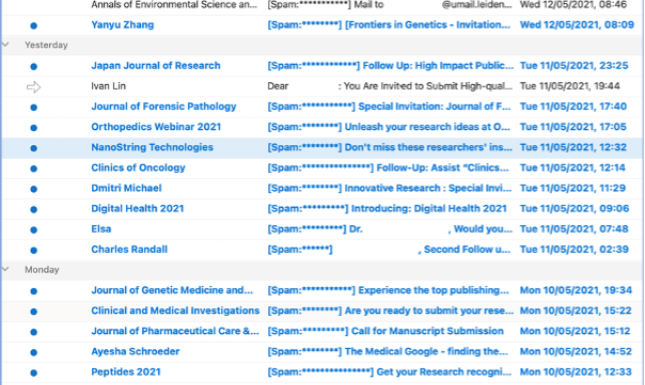Questionable and Predatory journals: How to spot and avoid them
In the 2021 Open Access Week, we would like to talk about peer review and maintaining high quality when publishing OA: we want to offer you some help to understand the problem with predatory journals, identify these journals in your own field, and avoid submitting your research to them.
Peer reviewers are the linchpin around whom quality academic publishing revolves. Reviewers and editors not only guard against poor quality research being published, they are also essential in helping authors improve their writing and research. This is a key reason to talk about predatory publishing during the 2021 Open Access Week. Just so you know, real peer reviewers have very little to do with predatory journals!
Top tips for avoiding bad journals
- Check journal contents thoroughly and avoid poor quality and counterfeit journals.
- Many predatory journals look very much like famous titles. Check that you are submitting to the right one.
- Don’t submit, sign, or pay anything unless you are sure the journal is trustworthy.
- If in doubt, contact the Open Access Team: openaccess@library.leidenuniv.nl
Open access: Good versus bad journals
There are thousands of high-quality, trustworthy open access journals published all over the world in every field. Unfortunately, there are also a growing number of low-quality, fraudulent, and counterfeit journals appearing online known as “predatory journals.” It can be difficult to distinguish the bad from the good.
This blog is here to help you understand the problem with predatory journals, identify these journals in your own field, and avoid submitting your research to them. In case you do accidentally submit to or publish in a predatory journal, you’ll also find out here what to do. Using the resources and checklists included below, we can help ensure that all Leiden research is published in trustworthy, high-quality journals.
Quick guide to evaluating a journal’s trustworthiness
- If their offer sounds too good to be true, it probably is.
- Look beyond the journal's title and check the quality of its contents across multiple issues.
- Be very critical of unexpected invitations to submit your article and very fast review times.
- If you receive an unexpected invoice for publishing, do not pay this. Get in touch with the Open Access Team: openaccess@library.leidenuniv.nl
Do you recognize this?
You've received an unexpected email from a journal inviting you to submit an article. The email promises extremely fast publication times or claims to have very famous editors, but you also spot strange formatting or spelling errors.
When browsing the journal’s website, you come across an article your colleague wrote for another journal. The new article makes no clear reference to the original.
You find a journal that looks a lot like a very famous journal but is now apparently hosted by an unfamiliar publisher.
Then you have likely come across a predatory journal.
In a recent blog post, Cabells, a journal analytics service that produces a list of predatory journals, announced that its list of predatory journals now includes over 15.000 titles and that this number increases at an average rate of 150 titles per month. Many of the journals recently added to the list are not necessarily new. Some of these journals have been deceiving authors and undermining science for years.
But what is predatory publishing and how does it affect Leiden researchers?
The problem with predatory publishing
Originally the term ‘predatory publishing’ referred only to intentionally counterfeit journals set up to make a profit at the expense of authors and scientific quality, as explained by Beall in Nature as early as 2012. Now the term has come to include poor quality due to inept management as well:
You can read more in Grudniewicz (2019).
Predatory journals are characterised by questionable or missing peer review, extremely quick article publication times, poor scientific reporting, spelling and grammar errors, formatting errors, and unclear article handling workflows. They also often lack clear licensing and copyright information or mix up various features of open access publishing and CC-BY licencing while claiming the publisher retains copyright. These journals often have an undefined scope (i.e. accepting articles well outside their stated purpose), advertisement targeting authors rather than readers, and a lack of retraction and retention policies, see also Samsheer (2017) and the so called Beall's List.
Concerningly, suspected and proven predatory journals have been found indexed in major journal database like Scopus (read more) and Pubmed (read more). To complicate matters further, instances of potentially predatory publishers purchasing legitimate journals have also been reported (read more).
Because their content cannot be guaranteed to be scientifically sound, predatory publishers and journals waste “people, animals and money” and undermine research in every field they publish in, see also Moher (2017).
Predatory publishing involving Leiden authors
It is difficult to quantify the scale of predatory publishing that involves Leiden and LUMC researchers. Journal articles authored by Leiden authors, and journals with Leiden based editors, appear in the catalogues of several known predatory publishers.
From contact with authors, we know that some of these articles have been stolen by a predatory journal from another publication. Some articles were submitted in response to an invitation email. Some articles have been submitted in error, either by authors confusing the journal with a legitimate and well-known title, or by authors seeking a niche journal and not realising the publication’s lack of scientific and ethical rigour. Leiden and LUMC staff have shared some examples of the emails they receive on an almost daily basis (see below) from predatory journals and conferences inviting them to submit work.
Once an article has been submitted to a predatory publisher, it can be extremely difficult to withdraw it. There is little to guarantee that the publisher won’t simply put the article online for the value of having an article with authors from a respectable institution on their website. This is why it is incredibly important to thoroughly research each journal you wish to submit your article to BEFORE submitting any work.
How to Avoid Predatory Journals
There are many signs that a journal or publisher is not trustworthy. To get started, there are a few thoughts to keep in mind which can help you spot a predatory journal well before you submit to one.
- As with any interactions you have with online businesses for shopping, booking holidays, or requesting services: If it sounds too good to be true, it probably is. For example, good peer review normally takes longer than a few days, OA publishing is normally not free, high metric scoring journals don't appear overnight.
- Titles including "the British journal of" or "[Journal name] International" (for example) don't automatically mean anything. Predatory journals often have very similar titles to famous journals. Look beyond the title and check the contents.
- Third, if a journal got in touch with you unexpectedly, be very critical of the invitation. Investigate the journal thoroughly and ask for a second opinion if you can't decide if the journal is trustworthy.
Signs of a predatory journal
If a journal exhibits several of these features, it’s possible that the journal is predatory.
Articles
- Are of poor quality or contain obvious scientific/grammar/formatting errors.
- Are published extremely quickly (within a few weeks from submission).
- Are republished from another journal without correct citation.
- have no clear copyright license (e.g. CC-BY) information.
The journal
- Looks a lot like another very famous journal.
- Belongs to a non-existent society.
- Does not appear in DOAJ, openaccess.nl, major scientific journal databases, or subject-relevant databases.
- Promises free OA publication or very cheap OA fees.
The editorial board
- Lists very famous people (despite the journal being small and unknown).
- Lists people who have no contact information and no real connection to the journal.
- Lists people who are not experts in a field within the journal’s scope.
Communications
- Emails and website have spelling or formatting errors (see example emails below).
- Websites are entirely directed at authors, not at readers.
- The journal title or publisher is referred to inconsistently in emails or on the journal website.
- Website lists a single phone number as author support line.
- In some cases, the listed phone number is shared by several predatory businesses. Put the phone number into a search engine and see how many businesses use it.
- Publishing company address is shared by many other companies.
- Type the address into a search engine and check what else operates from there.
Remain critical when receiving a peer review report on your manuscript. Some predatory journals do send a “review” to try and look legitimate. Do not trust a review that you received with a few days of submitting, is not specific about scientific quality, or is very light and suggest very minor changes. Real reviewers are extremely unlikely to recommend that your article be accepted right away, as is.
When a journal comes looking for you
Have you received an unexpected email from a journal (or editor) you don't know requesting that you submit an article? Then you have possibly been contacted by a predatory journal. Just like emails suddenly telling you that you've won an iPhone or a free cruise holiday, emails from predatory publishers are spam and trying to get something from you: data and money.
Trustworthy journals do occasionally invite authors to submit articles. This is one way in which high impact journals solicit their best articles, or their editors fill up a topic-specific special issue. It's not uncommon after a conference presentation, for example, for editors to reach out to potential authors and ask for those results to appear in their journal. It’s also possible that a journal you have published in before or with an editor who knows you may invite you to submit work. These emails from editors should normally be well written, state clearly what it was about your research that interested them and contain enough information for you to research the further contents and reputation of the journal (if you don't know it). The editors should also be happy to provide you with any more information you need.
Finding a good journal to publish in
The purpose of publishing your research is to contribute to the global knowledge in your field. Readers will use a journal’s reputation to know if they can trust your research. There is never an excuse for Leiden researchers to publish in a predatory journal. With thousands of trustworthy subject specific journals and several large sound science journals to choose from, there is always somewhere to safely publish your research.
Core publishing practices to which trustworthy and ethical journals should adhere have been outlined by the Committee on Publication Ethics (COPE).
When looking for a journal (or book series or other publication platform), there are several questions to ask which will help you find a good publication venue for your research:
Scope
- Will this journal/book/platform reach the right audience?
Quality
- Who else has published there?
- Do my advisors and colleagues know this journal/publisher/platform?
- Would I cite an article from this source?
- Who is on the editorial board? Are their contact details correctly listed?
- Is the journal indexed in major databases (DOAJ, Scopus, Web of Science, etc.)
- Does the publisher issue permanent identifiers (DOI is most common)?
- Are the stated quality metrics verifiable (IF, Citescore, Altmetrics, etc.)?
A reputable journal may still not meet each requirement perfectly but should certainly meet most of them before you proceed.
There are several tools and resources to help you check if a journal is trustworthy
- Directory of Open Access Journals (DOAJ)
- Think. Check. Submit.
- On openaccess.nl:
- The Open Access Journal Browser
- https://www.openaccess.nl/en/what-is-open-access/quality
- https://beallslist.net/ (revived from the original) lists suspected predatory journals
- Contact the Library's Open Access Team
Once you've decided on a journal and after you've submitted an article, there are still signs you should look out for to make sure you’ve made the right choice:
- The submission process for a large journal will normally be via a submission tool or website. Submission via email may be the set-up for small journals with a small submission load, but this is unusual for journals with several hundred (or thousand) submissions per year.
- Which editor is handing the review process for your article? Reputable journals will often tell you which of the editors (if there are several) will be handling your article. Check that this person really exists and works on the journal (e.g. Look for a university profile page or CV) and is indeed a relevant expert in your field.
- The peer review process for most reputable journals takes a number of weeks or months. Regard the review very critically if this is returned unexpectedly quickly.
- The reviews you receive of your article should be thorough and address the scientific content. Reviews making only superficial changes to formatting or grammar are suspicious.
With a critical eye and some fact checking work you will be well equipped for choosing the right place to publish your next article.
When things go wrong
You’ve accidentally submitted an article to, or published an article with, a predatory journal. This unfortunately happens to researchers in all fields at any stage of their career. Leiden University and the LUMC are very concerned about these articles and will work to help you retrieve your work or correct the publication record. Never pay a suspected predatory publisher anything and do not sign any agreements with them.
As each case is different, please contact the Open Access Team openaccess@library.leidenuniv.nl
for advice as soon as possible.
Example emails
Email 1: Very fast publication time, requesting email submission
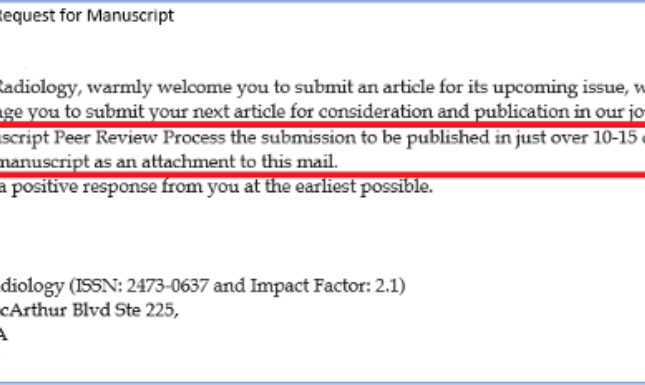
Email 2: Wide scope, poor language, very fast publication time, meaningless indexing
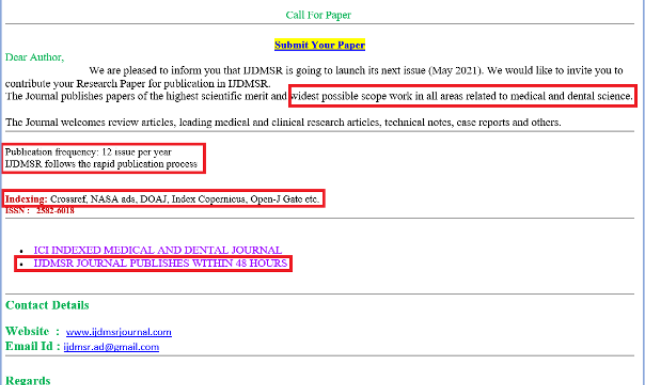
Email 3: Poor language, single phone number contact
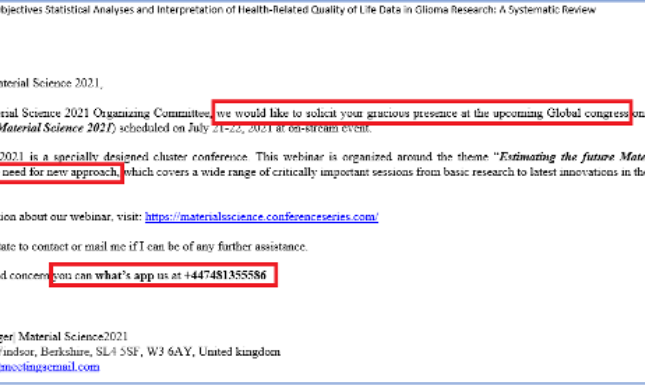
Email 4: Strange formatting, poor language, very general
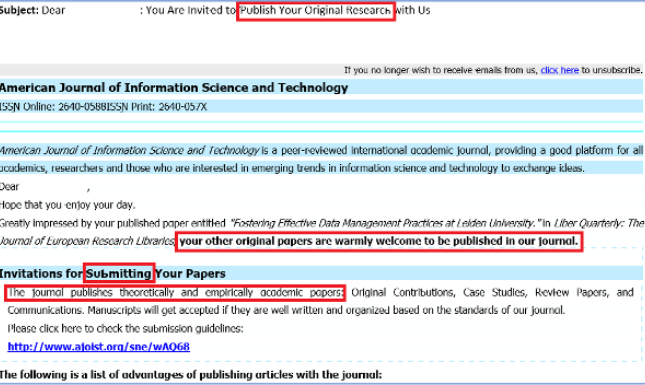
Email 5: Very general title, highlighted published article but no comment on why, meaningless indexation, promise of fast publication
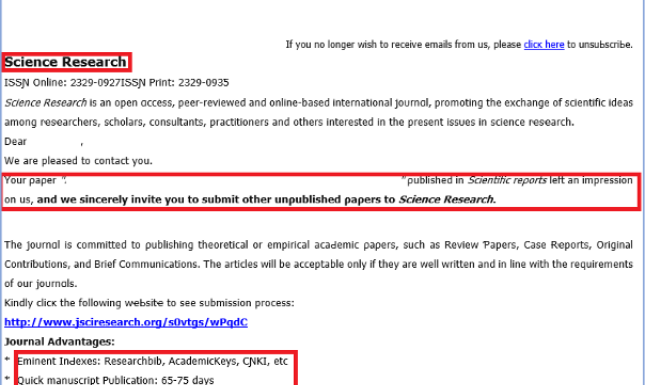
Multiple emails from predatory publishers received by a Leiden staff member in a day. Note that all but one was picked up as spam, meaning that manual checks are necessary.
